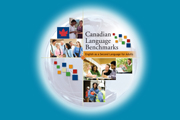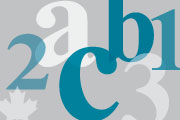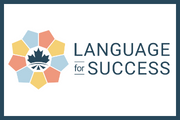
Promising Practices
The Language for Success (LFS) framework offers an insight into the relationship between two descriptive scales, Canadian Language Benchmarks (CLB) and Skills for Success (SFS), providing awareness of the language required to demonstrate the nine SFS: Adaptability, Collaboration, Communication, Creativity and innovation, Digital, Numeracy, Problem solving, Reading, and Writing.
These promising practices highlight methods and techniques that will work effectively to produce successful outcomes. They are intended for language learners, language instructors, program developers, employment counsellors, employers, and any other SFS practitioner working with language learners. They highlight the usability of the CLB and SFS through the LFS framework, offering guidance to end-users and stakeholders.
Notes of Interest to Users:
- SFS were not created explicitly to identify language requirements. The SFS proficiency levels do not align with the CLB levels. You should think of the two frameworks being complementary. Refer to the LFS framework to better understand the SFS and CLB levels.
- The LFS framework is not designed for literacy learners. It is designed for language learners with Reading and Writing skills in the CLB 1-12 range.
- The LFS framework is designed to address learners at Stage 1, Stage 2 and Stage 3 of the CLB. At Stage 1, current activities for the non-language skills may be more suitable for learners at CLB 3-4. Learners at CLB 1-2 may find these activities challenging.
Employment is key to integrating successfully into Canadian life. Both CLB and SFS are vital to finding and retaining employment for immigrants. The CLBs help learners understand their language ability and SFS helps them understand their ability in everyday skills for work, learning and life: LFS bridges the two, helping individuals understand how language impacts their ability to demonstrate the SFS.
Individuals in Canada will most likely have some degree of all nine SFS but may lack the language skills to demonstrate them effectively. LFS supports learners in acquiring the language necessary to demonstrate and further develop these SFS, as well as facilitating the integration of workplace-related learning into language classes. The LFS framework supports language instructors and program designers in identifying authentic workplace tasks and selecting SFS resources that are appropriate for specific CLB levels in workplace-related language activities. Because SFS provide the appropriate context for language learning, learners can see the immediate relevance of language learning tasks.
The main goal of language classes is to enable the learner to successfully apply the skills taught in the classroom to real-world contexts, such as the workplace. Classes increase language acquisition and a better understanding of Canadian culture. By incorporating LFS effectively, practitioners can provide relevant and practical teaching activities related to SFS, ultimately helping immigrants integrate successfully into the Canadian workplace.
CLB
SFS
- National framework for describing the language proficiency of adult immigrants in Canada.
- National framework used to describe skills for life, work, and learning in Canada.
- CLB and NCLC are the national standards in English and French for describing, measuring and recognizing second or other language proficiency of adult immigrants and prospective immigrants for living and working in Canada.
- Designed for everyone, regardless of first language, including employers, workers, training providers, governments, and communities.
- Describes language proficiency for the community, academic and workplace settings.
- Provides Canadians with everyday skills needed for work, learning and life.
- Has four skills: Listening, Speaking, Reading, and Writing.
- Has nine skills: Adaptability, Collaboration, Communication, Creativity and Innovation, Digital, Numeracy, Problem Solving, Reading, and Writing.
- The language skills of Communication, Reading, and Writing have direct correlation to the CLB as initially established by a CCLB study in 2005.
- The non-language skills of Adaptability, Collaboration, Creativity and Innovation, Digital, Numeracy, and Problem Solving do not have a direct correlation to CLB; rather, LFS makes evident the language involved in demonstrating them.
- Has 12 benchmark levels divided into three stages, Beginner (CLB 1-4), Intermediate (CLB 5-8) and Advanced (CLB 9-12).
- Has complexity levels of 1 to 5 for Numeracy, Reading and Writing; and Entry, Intermediate and Advanced levels for all other skills.
Most workplaces, as well as other real-world language contexts outside the classroom, are not designed with the distinct needs of language learners in mind. This table demonstrates some of the differences between language use in the classroom and language use in the workplace. This information can be helpful when asking:
- learners to consider the realities and demands of the workplace
- instructors to identify the needs of their learners
- employers to understand the challenges their employees face
|
Language Skill |
Language Use in the Classroom |
Language Use at Work |
|
All skills |
|
|
|
Listening |
|
|
|
Speaking |
|
|
|
Reading |
|
|
|
Writing |
|
|
Language learners may demonstrate proficiency in some, if not all, of the nine SFS. However, they may not have the language proficiency to demonstrate these skills in English or French. The LFS framework will support learners in acquiring and demonstrating the language in SFS, and since SFS are framed in a Canadian cultural context, practising them in the language classroom can increase the likelihood of successful communication in the workplace.
LFS can:
- reveal the transferable relationship between CLB and SFS, showing how they can be used in multiple contexts such as the classroom, the workplace, or any other real-world situation
- help increase communicative language ability and SFS, both of which are necessary for success in the workplace for all occupations
- give specific examples of language tasks in the workplace at different levels and stages
- support SFS development
- help identify skills gaps and develop strategies to meet those gaps
- demonstrate authentic workplace scenarios
Language Learners can:
- use LFS Can Do Statements to identify ability at different levels and stages
- complete LFS Self-assessments to gain awareness of approximate SFS levels
- do LFS Learning Activities to learn more about and practise skills within a workplace context
Most language instructors will have a good understanding of CLB but may have less familiarity with SFS. The LFS framework will support instructors’ better understanding of SFS and how to effectively use them in the classroom.
LFS can:
- demonstrate the transferable relationship between CLB and SFS, showing how they can be used in multiple contexts such as the classroom, the workplace, or any other real-world situation
- help instructors understand how typical workplace tasks relate to CLB levels and vice-versa
- demonstrate the language embedded in SFS, particularly the non-language skills of Adaptability, Collaboration, Creativity and Innovation, Digital, Numeracy, and Problem Solving
- give specific examples of language tasks in the workplace at different levels and stages
- facilitate the integration of workplace-related learning into language classes
- help identify skills gaps that language learners need to fill for successful workforce integration
- support the setting of language goals to close the skills gap
Language Instructors can:
- help learners identify the transferable skills between CLB and SFS
- use LFS to identify authentic language tasks that are connected to workplace language learning
- elicit information from their learners about real-life situations to emphasize transferable skills
- review LFS Can Do Statements with learners to identify and better understand the language embedded in SFS
- suggest learners do the LFS Self-assessments to understand their gaps and needs
- use the examples in the LFS Can Do Statements and Self-assessments to build real-world tasks when lesson or module planning
- use LFS Learning Activities in lessons
- use LFS Learning Activities as models / templates for creating new activities
Observations for Stage I (CLB 1-4):
- LFS was not developed for literacy learners
- While the SFS non-language skills (Adaptability, Collaboration, Creativity and Innovation, Digital, Numeracy, and Problem Solving) are captured in Stage I of the LFS, instructors may find them more suitable for using with CLB 3-4 learners. LFS has illustrations in the Can Do Statements and Self-assessments to help with comprehension for CLB 1-2 learners because the language used in SFS is more closely aligned with CLB 3-4
Approaches to creating lessons or modules with LFS:
- assess learners’ needs
- identify an authentic workplace task
- create an objective: identify the language-related competency from LFS that supports the demonstration of the workplace task
- source or create relevant classroom activities, ideally using authentic workplace documents or simulated workplace scenarios
- create the lesson or module, using skill building activities and skill using tasks
- assess the learners with an assessment task focused on the lesson or module objective
- use the LFS Learning Activities as models and templates for activity and lesson planning
Program developers may have a good understanding of either CLB or SFS, depending on whether they are primarily developing language or SFS programs. The LFS framework will support developers working in either context as it demonstrates how language identified in SFS can be used to enhance workplace-based language development.
LFS can:
- demonstrate the transferable relationship between CLB and SFS, showing how they can be used in multiple contexts such as the classroom, the workplace, or any other real-world situation
- help developers understand how typical workplace tasks relate to CLB levels and vice-versa
- demonstrate the language embedded in SFS, particularly the non-language skills of Adaptability, Collaboration, Creativity and Innovation, Digital, Numeracy and Problem Solving
- give specific examples of language tasks in the workplace at different levels and stages
- facilitate the integration of workplace-related learning into language programs or language learning into workplace-related training
- help identify skills gaps that language learners need to fill for successful workforce integration
- support the development of program needs assessments
- support the development of clear program objectives
- identify how clearly defined measurable outcomes demonstrate learner progress
Program Developers can:
- design LFS-aligned programs and curricula
- identify the transferable skills between CLB and SFS in curricula
- identify skills that language learners need for successful workforce integration
- use LFS to identify authentic language tasks that are connected to workplace language learning
- develop targeted instructional content based on LFS
- embed LFS Can Do Statements into curricula
- use LFS Learning Activities as models / templates for creating new activities
- use the examples in the LFS Can Do Statements and Self-assessments to build real-world tasks in curricula
Approaches to developing curricula with LFS:
- identify authentic workplace tasks
- create goals and objectives using language-related competencies from LFS that support the demonstration of the workplace tasks
- create curricula using authentic workplace documents and simulated workplace scenarios
Employment counsellors may have a good understanding of SFS but less familiarity with CLB. The LFS framework will help employment counsellors better understand how language proficiency impacts immigrants’ ability to acquire and retain meaningful work.
LFS can:
- reveal the transferable relationship between CLB and SFS, showing how they can be used in multiple contexts such as the workplace or any other real-world situation
- give specific examples of language tasks in the workplace at different levels and stages
- support SFS development
- help identify skills gaps and support development of goals to fill those gaps
- demonstrate authentic workplace scenarios
Employment Counsellors can:
- better understand how language impacts clients’ ability to demonstrate their skills
- identify workplace language needs
- recognize if clients’ language skills are sufficient to competently complete workplace skills
- better understand how to develop programming to meet language skills’ gaps
- use LFS Can Do Statements with clients to identify ability at different levels and stages
- use LFS Self-assessments to gain awareness of clients’ approximate SFS levels
Employers may have some or good understanding of SFS but less familiarity with CLB. The LFS framework will help employers better understand how language proficiency impacts immigrants’ ability to acquire and retain meaningful work.
LFS can:
- reveal the transferable relationship between CLB and SFS, showing how they can be used in multiple contexts such as the workplace or any other real-world situation
- give specific examples of language tasks in the workplace at different levels and stages
- support SFS development
- help identify skills gaps and support development of goals to fill those gaps
- demonstrate authentic workplace scenarios
Employers can:
- use LFS Can Do Statements with clients to identify ability at different levels and stages
- use LFS Self-assessments to gain awareness of clients’ approximate SFS levels
- better understand their employees’ abilities and skills
- use LFS to create awareness of the needs of language learners to improve communication in the workplace:
- encourage the use of plain language
- encourage active listening
- ensure workplace instructions are clear and accessible
- provide samples and models
- foster appreciation of diversity and inclusion
- LFS defines the relationship between the CLB and SFS frameworks. It is a high-level overview that demonstrates how SFS can be used in a language context and vice versa.
- LFS has been designed for low-stakes applications, such as classroom use. It is not intended for high-stakes language assessment or any other type of high-stakes assessment that could have significant impacts on a learner’s employment or life situation.









